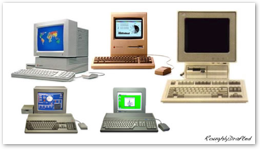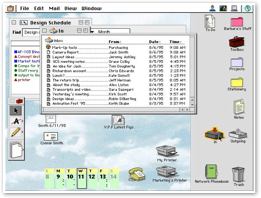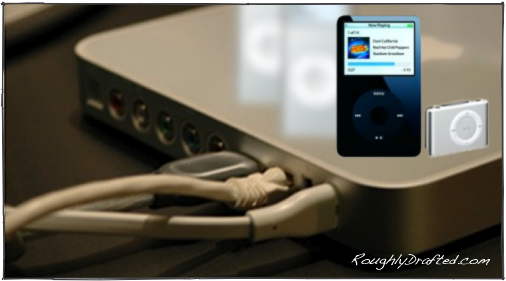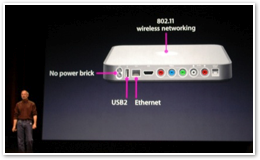
iPod, iPhone, iTV: Apple's New Platform
Apple's unfolding iPod strategy is so clear and obvious that it's hard to understand why the pundits are so confused. They seem to think that Apple has no plan, and is simply poking in random directions.
However, Apple quite pointedly does have a clear direction for all the products it has shipped, and that plan figures into what Apple will be releasing next year. That plan bears some resemblance to the introduction of the original Macintosh, and what that machine did to improve computing back in the 80's. Here’s a look at why.
This All Happened Before
Recall that back in the days before the Mac, a number of vendors were all trying to sell different, incompatible platforms. In addition to the Apple II and the IBM PC, there were also machines like the Kaypro and Osborne which ran CP/M, as well as a variety of consumer targeted machines like the Commodore 64, Tandy's TRS-80, the Coleco ADAM, Timex Sinclair 1000, and Texas Instruments TI-99/4A.

All that variety was actually a problem for consumers. Since every machine required different software, users had to pick a company that would stay in business long enough to ensure that software would arrive and would continue to be supported for the life span of the computer.
If the killer apps they needed didn't make it to their platform of choice, users might end up stuck with an extensive investment in obsolete hardware.
The PC Platform Solution
It was IBM's reputation in business machines that established its PC product as a de facto standard, but the company quickly lost any association with the PC it introduced because other companies, notably Compaq, were able to clone functionally identical PCs. That left Microsoft, IBM's software partner, to inherit the PC's fortune.
Microsoft's DOS, running on various makers’ IBM-compatible PCs, resulted in a reasonably open market for hardware combined with a closed market for software. That benefitted businesses who wanted a stable platform for application development.
Businesses buying PCs wouldn't have to worry if DOS applications bought in 1984 would still be around a few years later, or if the latest applications would be available. They knew the market for DOS apps was large enough to provide for just about anything they might need.
That didn't mean that DOS was much of a platform: DOS software was a huge mess. There were no standards for a consistent user interface or even keyboard shortcuts. Every DOS app made up its own conventions, provided its own printing support, and dealt with its own file types.

The Macintosh in Windows
When Apple unveiled the Mac, it expected the world to recognize the benefits of a clear and consistent user interface, with keyboard shortcuts that worked the same in every application and followed intuitive letter associations. The Mac System Software provided standard methods for everything from printing to handling files.
The Mac didn't catch on outside of desktop publishing and graphic design, where its graphical user interface offered clear advantages. Instead, the PC world would wait ten years before Microsoft would bring out a similar graphical user interface for the majority of PCs used in businesses.
Microsoft Windows delivered the innovations of the Mac to a wide audience. Apple missed out on doing that itself for a number of reasons. One was that the company was distracted by immediate profits it was enjoying, another was that it chose to litigate rather than innovate.
Apple frittered away its decade head start, and by the time it realized it, the company was nearly irrelevant as a mass market computing platform. 

Once the business world had settled on a solution, it wasn't interested in revisiting its decision, particularly as Apple's fortunes began to falter and the company's future roadmaps repeatedly fell apart. Windows has been 'good enough' to prevent much of a threat from Mac market share gains ever since the mid 90's.
Apple's New Platform
Apple learned a few hard lessons: don't complacently throw away the lead, don't value immediate price advantages over long term sustainability, and don't let success distract from the threat of competition. The company is applying those lessons to its new platform.
Like the Mac, this new platform is cleaning up a messy set of random efforts using a clean user interface that is accessible and intuitive. Also like the Mac, this new platform provides consistent ways to do a variety of different things that previously were complex and problematic.
The difference is that this time, Apple isn't about to let Microsoft or anyone else duplicate its efforts and take the credit for its developments. This new platform involves everything Apple does, including Mac OS X. It involves the iPod, the rumored iPhone, and the previewed iTV.
The following series of articles will describe what this new platform is, what it does for consumers and businesses, and why it will succeed in ways that Apple's earlier efforts with the original Mac did not. In addition to historical lessons learned, there are also changed circumstances and very different management and planning involved.
Next Article:
This Series










Sunday, December 10, 2006


 Bookmark on Del.icio.us
Bookmark on Del.icio.us Discuss on Reddit
Discuss on Reddit Critically review on NewsTrust
Critically review on NewsTrust Forward to Friends
Forward to Friends
 Get RSS Feed
Get RSS Feed Download RSS Widget
Download RSS Widget





